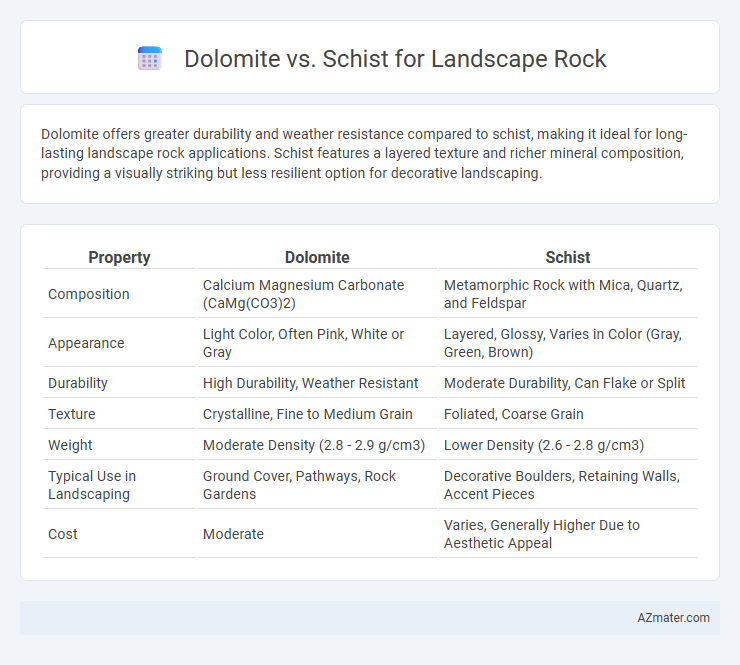Dolomite offers greater durability and weather resistance compared to schist, making it ideal for long-lasting landscape rock applications. Schist features a layered texture and richer mineral composition, providing a visually striking but less resilient option for decorative landscaping.
Table of Comparison
| Property | Dolomite | Schist |
|---|---|---|
| Composition | Calcium Magnesium Carbonate (CaMg(CO3)2) | Metamorphic Rock with Mica, Quartz, and Feldspar |
| Appearance | Light Color, Often Pink, White or Gray | Layered, Glossy, Varies in Color (Gray, Green, Brown) |
| Durability | High Durability, Weather Resistant | Moderate Durability, Can Flake or Split |
| Texture | Crystalline, Fine to Medium Grain | Foliated, Coarse Grain |
| Weight | Moderate Density (2.8 - 2.9 g/cm3) | Lower Density (2.6 - 2.8 g/cm3) |
| Typical Use in Landscaping | Ground Cover, Pathways, Rock Gardens | Decorative Boulders, Retaining Walls, Accent Pieces |
| Cost | Moderate | Varies, Generally Higher Due to Aesthetic Appeal |
Introduction to Dolomite and Schist as Landscape Rocks
Dolomite is a durable sedimentary rock composed primarily of calcium magnesium carbonate, favored in landscaping for its resistance to weathering and attractive light colors. Schist, a metamorphic rock characterized by its foliated texture and abundance of mica minerals, offers unique aesthetic appeal with its shimmering surfaces and varied hues. Both rocks enhance garden designs with their distinct textures and natural durability, making them popular choices for pathways, borders, and decorative rock features.
Geological Formation and Composition
Dolomite forms through the alteration of limestone by magnesium-rich fluids, resulting in a sedimentary rock primarily composed of the mineral dolomite (CaMg(CO3)2) with a crystalline texture. Schist, a metamorphic rock, develops from shale or mudstone subjected to intense heat and pressure, characterized by its foliated structure rich in mica, quartz, and feldspar minerals. The geological formation of dolomite imparts chemical stability and resistance to weathering, while schist's layered metamorphic composition provides distinct textures and varied mineral content for diverse landscape applications.
Visual Appearance and Color Variations
Dolomite landscape rock features light gray to white tones with occasional hints of pink or beige, offering a smooth, crystalline texture that complements modern garden designs. Schist exhibits a more varied color palette, including shades of green, silver, brown, and black, with a foliated, layered appearance that adds depth and rustic charm to outdoor spaces. The distinctive glittering mica flakes in schist create a dynamic visual effect, making it ideal for landscapes requiring textured, multi-tonal rock elements.
Durability and Weather Resistance
Dolomite offers superior durability and weather resistance compared to schist, making it an excellent choice for landscape rock in harsh environments. Its dense, crystalline structure resists erosion, freeze-thaw cycles, and chemical weathering more effectively than schist's foliated, layered composition. Schist, while aesthetically unique with its shiny, flaky surfaces, tends to be less stable and can degrade faster under prolonged exposure to moisture and temperature fluctuations.
Suitability for Different Landscaping Applications
Dolomite offers excellent durability and resistance to weathering, making it ideal for pathways, retaining walls, and water features in landscaping. Schist's foliated texture and natural shimmer provide aesthetic appeal for decorative rock gardens, accent pieces, and low-traffic areas. Dolomite's hardness suits heavy-use applications, while schist's softer structure favors visual interest in less demanding environments.
Maintenance Requirements and Longevity
Dolomite offers low maintenance requirements due to its hardness and resistance to weathering, making it ideal for long-term landscape applications. Schist, while visually appealing with its layered texture, may require more frequent upkeep as it is softer and prone to flaking and erosion over time. The durability of dolomite ensures a longer lifespan in landscaping projects, whereas schist's susceptibility to breakdown can shorten its longevity.
Environmental Impact and Sourcing
Dolomite, a sedimentary carbonate rock, is often sourced from quarries with minimal habitat disruption due to its widespread availability, resulting in a lower environmental footprint compared to more niche materials. Schist, a metamorphic rock with foliated layers, typically requires extraction from mountainous regions, which may involve more extensive land disturbance and energy consumption during mining. Both rocks offer durable landscape options, but dolomite's more abundant deposits contribute to reduced environmental impact and easier sustainable sourcing.
Cost Comparison and Availability
Dolomite rock typically costs less than schist due to its more abundant deposits and easier quarrying processes, making it a budget-friendly option for landscape projects. Schist, known for its distinctive layered texture and aesthetic appeal, often commands higher prices influenced by limited availability and more complex extraction methods. Both materials are generally accessible through regional suppliers, but dolomite tends to have broader availability, especially in areas with sedimentary rock formations.
Popular Design Styles Using Dolomite vs Schist
Dolomite is favored in modern and minimalist landscape designs for its smooth texture and light neutral tones, providing a clean and understated aesthetic. Schist is popular in rustic and naturalistic garden styles due to its layered structure and rich color variations, which add depth and organic character. Both materials enhance outdoor spaces by complementing the intended design theme and balancing durability with visual appeal.
Choosing the Right Stone for Your Landscape Project
Dolomite offers durability and a subtle color range of white, gray, and cream, making it ideal for creating a clean and polished look in landscape projects. Schist, characterized by its flaky texture and vibrant hues such as silver, green, or brown, provides more visual interest and natural texture for rustic or woodland garden designs. Selecting the right stone depends on the desired aesthetic, with dolomite suited for formal, low-maintenance landscapes and schist enhancing organic, textured environments.

Infographic: Dolomite vs Schist for Landscape Rock
 azmater.com
azmater.com